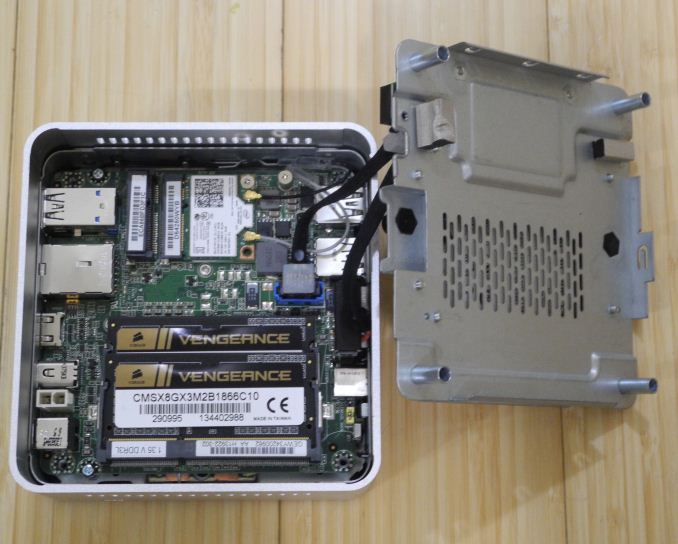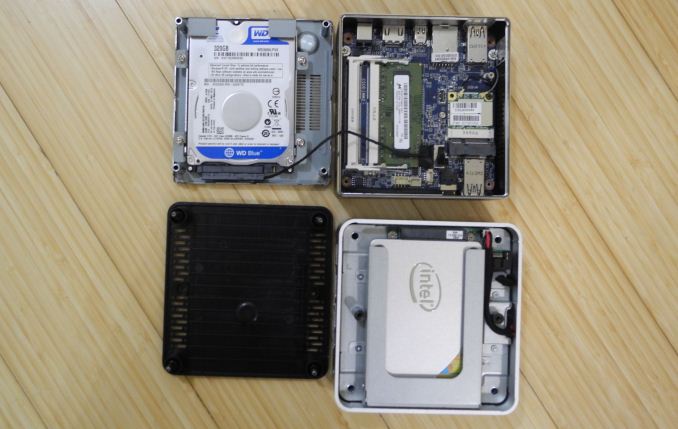Intel D54250WYKH Haswell NUC Kit with 2.5" Drive Slot Mini-Review
by Ganesh T S on May 18, 2014 10:15 AM EST
Introduction
The Intel NUC category has been an interesting product line to analyze, as it provides us with insights into where the traditional casual / home use desktop market might end up. This year, we have already reviewed two different NUC systems, the Intel D54250WYK and the Logic Supply Core ML320. The Intel D54250WYKH is fundamentally the same as the D54250WYK, except for the presence of a 2.5" drive slot. Since we have already looked at the performance of the Haswell i5 NUC platform in detail, this mini review will give us a chance to comment on the chassis redesign as well as an opportunity to see what different DRAM and storage can do to performance.
Inside the D54250WYKH:
In terms of external looks, the only difference between the D54250WYK and D54250WYKH are in the height of the system. Our D43250WYKH NUC kit came with an Intel SSD 530 240 GB 2.5" drive pre-installed. It could be accessed after removing the four screws holding the underside cover to the chassis.
While the Wi-Fi card (Intel AC-7260) that we saw in the D54250WYK review was present here too, we were free to choose the RAM this time around. Corsair came forward with a 8 GB Vengeance high performance DDR3L SODIMM kit capable of running at up to 1866 MHz with a CAS latency of 10 cycles.
Accommodating the 2.5" Drive:
Since the performance of the i5-4250U in the NUC board is quite well known (after two reviews), one of the important aspects that we cover in this review is the chassis modification for accommodating the 2.5" drive. For comparison purposes, we use a pre-production sample of the BRIX H-series PC (this is the standard BRIX board with the chassis slightly redesigned to accept 2.5" drives up to 9mm in height. The internal layout of the support for the 2.5" drive in both the versions is visible in the picture below.
While Gigabyte has opted to mount the drive bay flush against the chassis lid, Intel has a metal contraption on top of the motherboard in which the drive bay is integrated. The gallery below gives a closer look at both the designs. The first three pictures show the BRIX H design where the SATA data and power pins are brought out from the board to interface with a thin horizontal connector cable. This type of cable used to be popular during the netbook era (and even now, in notebooks such as the Razer Blade Pro). At the other end of the connector cable, we have a breakout into the standard SATA data and power connector for interfacing with the disk drive (as shown in the top segment of the photograph above).
The last three photographs in the gallery above show the Intel approach. Since the NUC board has separate SATA data ports and power connectors on the motherboard, Intel is unable to provide a clean solution to the problem of interfacing with the 2.5" drive. In the first of the Intel NUC photos in the gallery above, we have the power connector on the top metal layer visible. We can follow this to the SATA power connector on the main board by unscrewing the metal layer. This also provides us with a look at the SATA data cable which connects to a similar slot on the metal layer. All these results in the height of the chassis being more for the D54250WYKH compared to the BRIX H model. It is also not a surprise that disassembling the BRIX H to install a new drive / mSATA SSD / RAM is much easier than doing the same on the NUC chassis with the 2.5" drive slot.
In the rest of this review, we will have a few sections presenting various benchmark results (including wireless and storage system evaluation numbers). A section on power consumption and thermal performance precedes the concluding remarks. However, prior to all that, we have a table presenting the details of various systems that are compared against the D54250WYKH in this review.
| Comparative PC Configurations | ||
| Aspect | Intel D54250WYKH | |
| CPU | Intel Core i5-4250U | Intel Core i7-3720QM |
| GPU | Intel HD Graphics 5000 | Intel HD Graphisc 4000 |
| RAM |
Corsair Vengeance CMSX8GX3M2B1866C10 10-10-10-32 @ 1866 MHz 2x4 GB |
Super Talent W1333SB4GH 9-9-9-24 @ 1333 MHz 2x 4GB |
| Storage |
Intel SSD 530 Series (240 GB, 2.5in SATA 6Gb/s, 20nm, MLC) |
Intel® SSD 330 Series (60 GB, SATA 6Gb/s, 25nm, MLC) |
| Wi-Fi |
Intel Dual Band Wireless-AC 7260 (2x2 802.11ac - 867 Mbps) |
N/A |
| Price (in USD, when built) | $671 | $1300 |
























36 Comments
View All Comments
AgeOfPanic - Monday, May 19, 2014 - link
I use a Haswell core i3 version of the Gigabyte Brix with a OCZ Vertex SSD and I really like the system. Great form factor and mounting it behind the monitor makes for a very clean system. I don't think I'll go back to a different form factor for normal desktop systems again.To reply to the issue with the Intel AC760. I replaced the standard wifi card in the Brix for a Intel AC760 version. I use the standard drivers from Windows 8.1. I cannot reliably connect to the 5 GHz network of my Asus AC66u router. It works OK on the 2.4 GHz band, but I'm a little disappointed in this. Seems the drivers definitely need to mature.
Laststop311 - Monday, May 19, 2014 - link
This nuc is only good if u want to turn your dumb tv into a smart tv that's smarter than all tv's with built in smart functionalities. Gaming on ULV graphics = boooooooo. If you want to game in this tiny form factor you should get an amd apu. 5000 blowsdblagent - Monday, May 19, 2014 - link
Quick question that I assume I already know the answer to, these will support dual video output correct? I assume they will, and if so then I could see moving my entire office over to these in the future. I just built 40 desktops and building these would be a world easier.They all have Samsung SSDs so this new 2.5 form factor support will be a savior, though I'm set for several years now. Maybe as I get some more users I will build these over my custom built solution. Would save me some grey hair!
ptmmac - Monday, May 19, 2014 - link
Am I the only person who would like to see a single slot Pci for the 750 ti from nvidia in something this size?. I realize it would increase the power envelope, but it would also make gaming practical. AMD is supposedly working on a competitor for the 750 ti and this would give the purchaser a better set of options.run - Monday, May 19, 2014 - link
The hard disk is where the operating system and all software applications are stored. Because of this, a properly working drive is essential in the operation of any computer or laptop.CSMR - Tuesday, May 20, 2014 - link
Questions:1. How well damped is the 2.5" hard drive cage? I think this is mainly for regular HDDs (since you get mSATA for SDDs) so I am interested in how noisy HDDs are in this case.
2. The TrueCrypt benchmark doesn't look so good. Does this suggest that with native Windows whole-drive encryption, that encryption will limit read/write speed? I would have expected with AES-NI to get hardware encryption and decryption at closer to the SATA limit of 6Gbps.
darckhart - Tuesday, May 20, 2014 - link
ganesh, have you tried installing windows 8 via uefi msata gpt on this intel nuc? i updated the nuc bios to 25, but the msata (crucial m550 256gb) is still undetectable via uefi. shows up just fine in legacy bios. wondering if this is a nuc issue.prophet001 - Wednesday, May 21, 2014 - link
It was a mission to find out what NUC stood for. Might want to include that in the future.:)
kaymack - Wednesday, May 21, 2014 - link
This article seems to imply that the D54250WYKH model has only the 2.5" drive bay available for storage and no MSATA slot. Based on info I've seen elsewhere, I was under the impression that the D54250WYKH model will accept an MSATA drive on the board AND a 2.5" drive in the bay...so one could have say a Crucial M550 MSATA as the boot drive for OS and programs and also contain a 2.5" HDD or SSD for additional storage of data, music, video, etc. Can anyone confirm this?Jas448 - Saturday, May 31, 2014 - link
I have installed windows 8.1 to a Crucial 240 M500 msata and using a sanDisk SSD250Gb as a 2nd drive in the 2.5 inch bay. No problems at all. The only problem I had was Windows would not install from a USB3 flashdrive but would from a USB2 Flashdrive